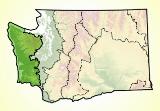 © Pete Saloutos/Panoramic Images (Washington Title Image Large)
© Pete Saloutos/Panoramic Images (Washington Title Image Large)

Northwest Coast Human Impact
The Northwest Coast’s marine and terrestrial ecosystems face myriad human-caused challenges to biodiversity conservation.
In nearshore and marine habitats these challenges include:
- Shoreline modification. Construction of jetties, bulkheads, and other armoring features has disrupted natural wave functions and led to shoreline erosion. In just one century, the jetty at Grays Harbor has reconfigured the estuary, changing it from a shallow bay with sandy beaches to a steep-faced shoreline with a deeper nearshore.
- Estuary conversion. More than 80% of the state’s estuarine ecosystems have been converted to other uses. Nearly all of what remains has been degraded. Roughly 40% of the Columbia River estuary has been drained to become dry land.
- Marine invasive non-native species. Smooth cordgrass (Spartina) covers nearly a third of Willapa Bay’s mudflats. It alters the funcitoning of the mudflats and challenges oyster culture.
Challenges to the terrestrial environment include:
- Low density sprawl. Beach communities like Westport and Ocean Shores face creeping residential and commercial development. This can disrupt the natural forces at work on beaches and dunes, and in turn disturb or dislocate the natural flora and fauna.
- Past forest management practices. Many of the forests in the Northwest Coast ecoregion have seen several harvest cycles. This legacy of single-aged stands, altered hydrology, and soil erosion creates challenges for biodiversity conservation.
- Invasive plant and animal species. Reed canary grass chokes many wetlands and streams. Himalayan blackberry, gorse, Scot’s broom and many others threaten the habitats of native plants and animals.
Biodiversity conservation in the Northwest Coast ecoregion, with its wealth of ecosystem diversity, holds both promise and challenge. Coordinated efforts among private and public entities will go a long way toward addressing the principal risks to its biodiversity.
For details of this ecoregion within Washington, click a subheading in the left column.
View the more general description of this ecoregion in North America



